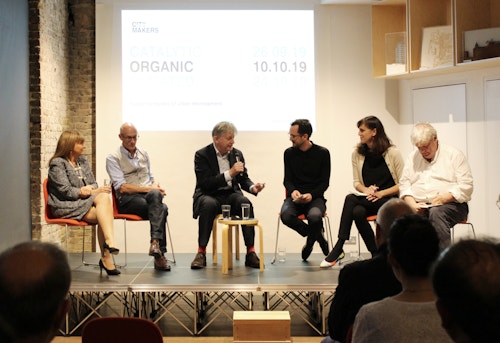/ Citymakers: Organic
In the absence of any formal plan, how do neighbourhoods manage growth and accommodate change?
by Artur CarullaFor the second edition of Allies and Morrison’s autumn 2019 conference, three speakers, Partner Artur Carulla, London Borough of Southwark chief executive Eleanor Kelly and developer Roger Madelin responded to the question while panellists Deyan Sudjic, Director of the Design Museum and Elizabeth Rapoport, Strategic Development Manager at Meridian Water, and curator and writer Jeremy Melvin, later expanded the discussion to interrogate the process of organic change in the city.
Artur opened the evening with the practice’s experience as one of several participants in the evolution of Bankside. At the turn of the twenty-first century, we set up our studios here as we undertook a major commission for developer Land Securities. Situated within the London Bridge Opportunity Area, the area has since delivered over 150% of initially anticipated development with a relative lack of a top down vision. Bankside’s fragmented intensification created a place of surprise and delight, elements often found in grassroots transformation that many masterplans yearn to recreate. It flourished because many different agents contributed, but also because it had in it a DNA for success: existing infrastructure, a good location, a tight urban grain.
There are many different factors that can be attributed to Bankside’s success. For Eleanor Kelly, culture has been one of its foundations. For her, the renaissance of the neighbourhood began with Sam Wanamaker’s efforts to open Shakespeare’s Globe on its historic site. In the time since, nine theatres opened in the wider surrounding. The Globe has since expanded. This would not have happened without some degree of planning. And of course, there was Tate Modern which took up residence in the former Bankside Power Station. Kelly referred to the Council’s decision to create better connections between the old power station and Blackfriars which unlocked it to become the most visited modern art gallery in the world.
In Roger Madelin’s experience, there has always been a skeleton on which places were built. In the example of King’s Cross, the framework of streets and spaces anticipated and facilitated future development. Drawing on examples at Brindleyplace, Birmingham and the more recent Canada Water project, Roger held that the fundamentals of location and of property are essential for a project’s long-term resilience. In his interpretation, an organic development is one that responds to market opportunities.
The panel and audience questioned the semantics of the word ‘organic’. Deyan Sudjic and Jeremy Melvin contested the idea that organic development is a sensible metaphor after all, much rather we should see urban transformation as the byproduct of economic, pragmatic, geological and climatic undercurrents. The city is not random. Planning, whether neatly organised or bottom-up, always needs to adapt to changing factors and is more often than not the outcome of a very specific moment in time.
Historically, the desire to enforce more ordered urban planning in London emerged precisely because it has largely been an unplanned place, noted Elizabeth Rapoport. It was the Victorians who were confronted with health issues who used the blunt instruments of planning to tackle these issues to create a more planned city. So rather than something completely organic, the process of urban change in London has always been more a negotiation, shaped by circumstance, which must allow for complexity and the unexpected to happen.
Planning is neither wholly organic, curated or catalytic. It cannot be neatly cut and sectioned.
